Comparo: Honda Jazz CVT vs Maruti Suzuki Baleno CVT
The 2016 anniversary issue of OVERDRIVE had an excellent piece on the stress factors of driving in the big city. The data showed that daily immersion into the battlefield that is our grossly overcrowded, unruly roads does no favours to your health. Driving in cities like Mumbai is such a mental fornication that I consciously chose to ride my motorcycle at every opportunity. Still, on the days when I simply have to drive, it's cars like these two that would be my first choice. Even though the stress test data indicated that automatics don't significantly reduce stress levels, they certainly reduce the effort of driving. I'll take that happily!

The two cars here, the Honda Jazz and Maruti Suzuki Baleno, both offer well-appointed, comfortable cabins in a form factor that isn't a handful in heavy traffic. Despite the compact dimensions, cabin and boot space is enough for these cars to suffice as the sole vehicle for a small family. Endearing factors indeed, but most importantly, both cars also offer a CVT automatic gearbox. CVTs promise a much more relaxed driving experience without significant sacrifices on fuel economy. Question is which does the job better?
The engines in both these cars are familiar 1.2-litre petrols that have found a home in the lakhs of Swifts, Ritzs, Balenos and Jazz' across the country. Both are smooth and rev happy with a zingy top end but without much go at low revs. Both make nearly the same power, the Baleno at 84PS and the Jazz at 90. The Baleno makes up for the power deficit with 115Nm of torque produced at 4,000rpm vs 110Nm at 4,800rpm for the Jazz. Our experience with the manuals shows that the Baleno displays a stronger bottom end, but with the CVTs the difference is less noticeable. In fact, these two CVT 'gearboxes' are rather different from each other in the way they function. They also change the character of both cars quite a bit over their manual siblings.

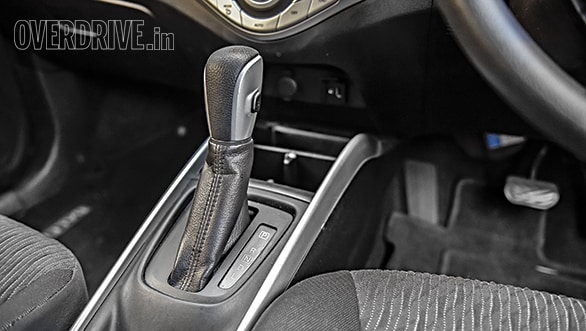 The Baleno's automatic shifter has a Sport mode button and an L (low) mode for steep inclines
The Baleno's automatic shifter has a Sport mode button and an L (low) mode for steep inclines
A CVT or continuously variable transmission, in very simple terms, replaces the fixed gear ratios of a standard manual/automatic transmission with two pulleys connected by a belt. One pulley is connected to the engine output shaft and the other is connected to the transmission and eventually to the driven wheels. The beauty of the CVT is that these pulleys can both change their size depending on the load to the engine, and by doing so they effectively create an endless number of possible ratios. The result is that the CVT will hold the engine at the exact point in the rev range based on your demand. Light throttle input will keep the revs low while flooring it will hold the engine at the point where it makes peak power, nearly 6,000rpm in the case of these two. Think of how your old Kinetic Honda used to sit at one steady high rev when you whacked the throttle open. The benefit of this system is that it's efficient, but also keeps the engine right at peak power point when required.
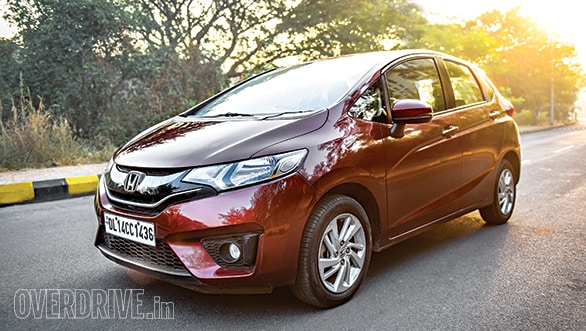
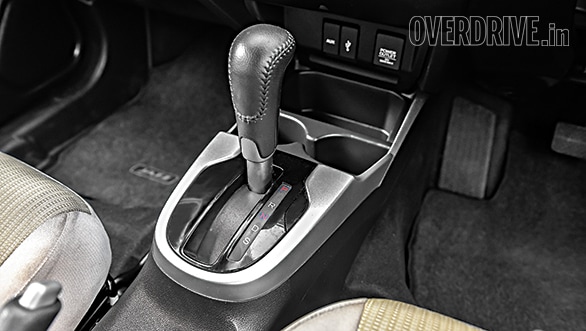 The Jazz's gearbox gets a Sport mode and steering-mounted paddle shifters
The Jazz's gearbox gets a Sport mode and steering-mounted paddle shifters
The reason I've explained the above is to point out the key difference between these two transmissions. The Baleno CVT works in the traditional way - you get on the gas, the engines revs up and holds its revs till the driver lifts off. The Honda CVT, on the other hand, also has seven built-in shift-points in the software. Though it's a little counterproductive to the logic of the CVT, it goes a long way in making the car feel like a traditional automatic gearbox with different gears. The Maruti, on the other hand, gives you no way to select gears but it does have a little Sport button on the gear shifter that sharpens up responses. There's also an L mode in the shift gate that keeps revs high for steep uphill work. The Jazz, meanwhile, offers a Sport mode in the shift gate but also has steering-mounted paddle shifters that provide a enjoyable and familiar sense of 'control' when driving aggressively.
But those looking for an entertaining driver's car would never consider a CVT hatchback. So while we would normally celebrate the fact that the Baleno is faster than the Jazz from 0-100kmph (11.6s vs 12.8s), I don't think it really matters here. What does, however, is the fact that the Baleno is more efficient, returning an overall 14.4kmpl to the Jazz's 13.1kmpl. It's a simple lesson in physics really the Baleno CVT weighs in at just 935kg which makes it 131kg lighter than the Jazz CVT.
The fact that the Baleno CVT is both faster and more economical seems very fetching, but there's more to it. The actual driving experience in the Jazz feels considerably more refined and upmarket. The Baleno's ever-willing and boisterous nature of making the revs soar every time the driver prods the throttle with conviction quickly gets tiring, especially on the highway. The Jazz is much calmer in this regard the electronic shift points greatly reducing the rubber band effect of the revs sitting at one point while the car gains speed. The Honda engine is also a fair bit quieter in the cabin at high revs, and the steering-mounted paddles are reasonably functional when you want to use them. This makes the Jazz the more pleasurable car to drive in any given situation, be it bumper-to-bumper traffic or high-speed highway work.
Another point worth mentioning is the throttle response at low speeds, both displaying different tendencies. The Baleno has a quick, almost startlingly sharp response to the accelerator at crawling speeds while responses on the Jazz are much more relaxed with a small delay followed by a surge forward. Personally, I like the Baleno's reactiveness, but most will prefer the Jazz's softer response. Both take some getting used to though.
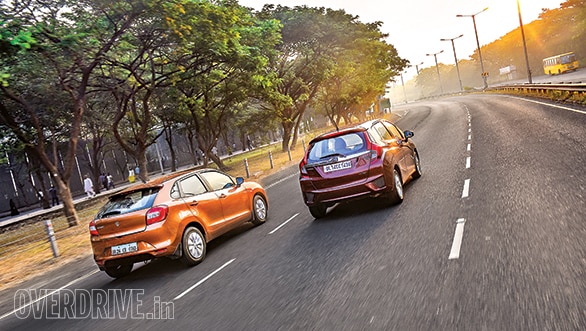
At our recent mega hatchback track test, we found both the Jazz and Baleno to be good handlers, the Baleno taking the edge thanks to its flatter ride and firmer set-up. This is clear on the public road where the Baleno displays less body roll but more stiffness and a higher tendency to thud over potholes and broken stretches. The Jazz feels more plaint and absorbs bumps better, making it the more comfortable of the two.
People tend to associate low weight with instability, but both the Baleno and Jazz are very stable at highway speeds and this is really no concern. Where the Jazz shines is in the braking department, something we also noted at the racetrack. The Honda stays remarkably stable under hard braking and held a straight line in our 100-0kmph brake test. The Baleno, meanwhile, gets a bit squirrelly and needs minor steering connections. I believe this is due to the MRF ZVTS tyres on our test car that aren't very grippy and quite noisy compared with the Michelin Energy XM1s on the Jazz. Maruti has a few tyre vendors and according to the company representative we spoke to, the tyres you get cannot be predicted - you could end up with the MRFs or the Apollo Alnacs like the ones on our diesel long termer. Hope for the latter.
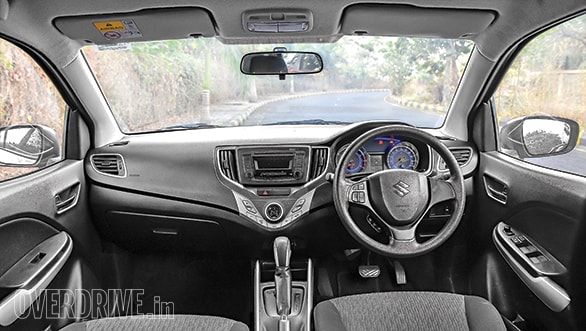 The Baleno gets a well-designed dash but the Apple CarPlay/Android Auto touchscreen system from the top model is missed
The Baleno gets a well-designed dash but the Apple CarPlay/Android Auto touchscreen system from the top model is missed
 The Baleno has a spacious cabin with generous rear kneeroom
The Baleno has a spacious cabin with generous rear kneeroom
Finally, we must consider the cabins. Unfortunately, both manufacturers don't see fit to offer the automatics in top-end trim, so you can have the Jazz CVT in second lowest S or second highest V trim. The same applies for the Baleno - second lowest Delta or second highest Zeta trim. The Baleno we have here is in Delta trim, but we'll assume the features of the Zeta variant so that these two are on an even playing field. The Baleno appears to be the better kitted version, with features like auto-headlamps, a full-colour MID, keyless entry/push button start, 60:40 split rear seats, and UV filtering glass that reduces cabin temperature and sunlight intensity. The Jazz responds to the Baleno's parking sensors with a reverse camera with multiple selectable views and a touchscreen climate control system that's easy to read and use. The Jazz also offers a touchscreen audio system compared with the Baleno's simple black and white readout. The Honda also produces considerably better audio quality. Despite the lower number of features, the Jazz cabin looks more premium in these trims as the Maruti's lovely Apple CarPlay/Android Auto touchscreen system is reserved solely for the top Alpha trim which is manual only. The quality of plastics and the way the cabin put together also feel a little tougher and more durable in the Jazz.
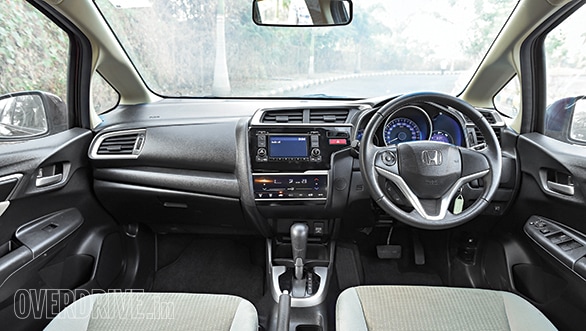 In these lower-spec trims, the Jazz dash looks more premium. Touchscreen audio system doubles up as reverse camera screen, but no parking sensors
In these lower-spec trims, the Jazz dash looks more premium. Touchscreen audio system doubles up as reverse camera screen, but no parking sensors
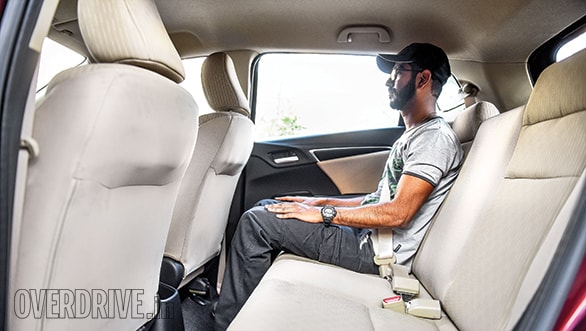 Where the Baleno is spacious, the Jazz is even more so, with segment-leading rear kneeroom
Where the Baleno is spacious, the Jazz is even more so, with segment-leading rear kneeroom
The Baleno has a very spacious cabin but the Jazz is even more so. Rear space is segment leading in terms of kneeroom, and even the transmission tunnel is low enough for it to be a comfortable 3-seater. Boot space is generous on both (Jazz 354 litres Baleno 339 litres), but the Baleno has a very tall loading lip making it harder to pack. In terms of safety, we're happy to report that ABS and airbags are standard on both CVT models regardless of trim. As for the looks, both cars have been around for a while now and plenty has been discussed on the matter. It's purely a personal matter of choosing between the Jazz's funky youthfulness and the Baleno's unique flowing lines. I'm equally fond of both.
When I wrote the comparison story for premium diesel hatchbacks a year back, the Baleno came out as the clear winner, over both the Jazz and the i20. Here, however, it isn't as cut and dried. Personally, I'm very fond of the Jazz because it does a better job of offering what I want in such a car a relaxed, comfortable and pleasurable driving experience. If it was my money, this is the car I'd have.

However, money ends up being the deciding factor here. If both cars were priced on par, the Baleno's better performance, efficiency and features could be ignored for the Jazz's superior automatic driving experience - that is exactly what the car is being bought for, right? However, Maruti has an ace up its sleeve with the Baleno's pricing. At Rs 9.2 lakh on-road Mumbai, the Baleno Zeta CVT is a whole Rs 70,000 less than the Rs 9.9 lakh Jazz V CVT. Unless money is no object, the Baleno wins again
Starts Rs 5.89 Lakhs
1199cc
Automatic
90
110
17.1 Kmpl
Starts Rs 6.35 Lakhs
1197cc
Manual
90
113
22.94 Kmpl














